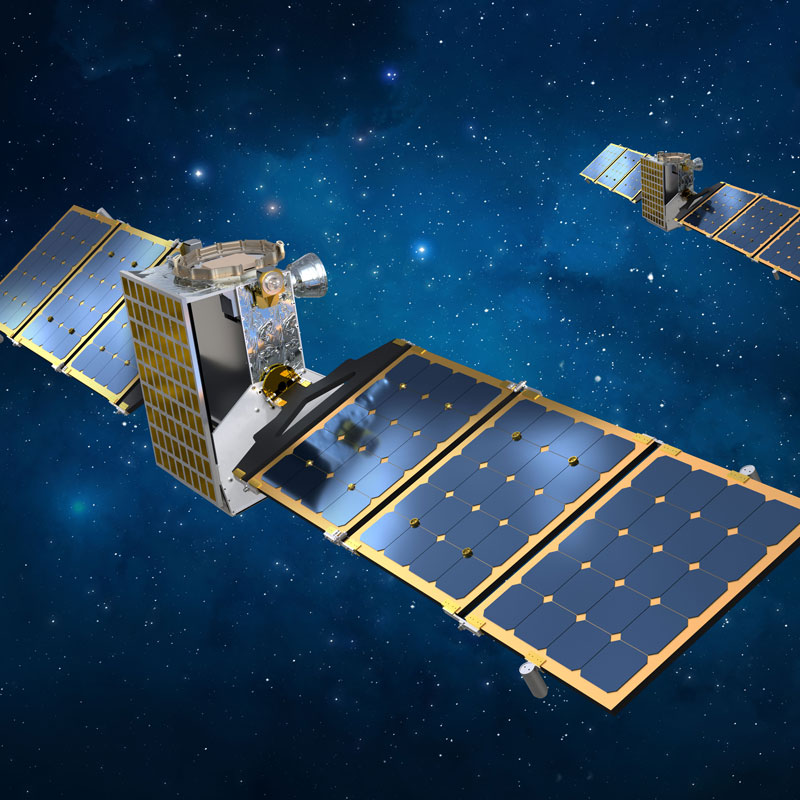
|
 |
Janus illustration (Credit: Lockheed Martin) |
|
Launching in 2022, the NASA SIMPLEx Janus Mission is a mission of twos. Named for the two-faced Roman god of beginnings and passages, the mission is sending a pair of craft deep into space to investigate two pairs of binary asteroids—1996 FG3 and 1991 VH—each containing a primary asteroid and a moon, called the secondary asteroid.
Joining the Janus Mission as mission scientist is aerospace engineering Associate Professor Christine Hartzell, whose previous NASA work includes the recent OSIRIS-REx mission to study asteroid 101955 Bennu.
“My responsibility for the Janus Mission is to ensure that the spacecraft take the measurements that we need them to take to achieve the science objectives,” explained Hartzell. “I also need to understand both the science, and pay close attention to the engineering design decisions to make sure they match our requirements.”
After riding along with the launch of NASA’s Psyche mission in 2022, the Janus twin crafts will first complete an orbit around the Sun, before heading back toward Earth for a gravity assisted sling-shot far into space and beyond the orbit of Mars for their four-year journey to the asteroids.
Each pair of asteroids presents different orbital patterns, and the goal is for the suite of cameras onboard Janus’ small satellites (SmallSats) to carefully track these dynamics to build an accurate model of the two different binary asteroid systems. The images will also be used to study the geologic features on the surface of these binary asteroids. They only have a short window of time to do it.
“It’s just a flyby, so we only have a few minutes when we can capture high resolution images of the surface” said Hartzell. “But we’ll have a cruise period before then where we’ll have opportunities to calibrate and test the instruments to make sure the cameras are working the way they are supposed to be working when they arrive.”
This mission is the first of its kind from NASA’s Planetary Science Division to utilize craft this small—about the size of a suitcase—for scientific exploration. The advantages of these smaller craft is that they are less expensive to build and can be launched as a secondary payload. The downside is that they take a long time to transmit data back to earth.
“We’re going to take something like 300 images, but since we can’t send them all back at once, we need to be able to make decisions about which images to send back first,” explained Hartzell. “What I have been doing for the mission is taking the images we have of Bennu, compressing them, and seeing what they look like compressed to determine if we have enough information from the compressed images to make decisions about which images to downlink first.”
Beyond the mission objectives set by NASA, Hartzell is also hoping to get some insights for her own area of research which focuses on the surface environments and characteristics of celestial bodies, and in particular regolith—the loose, dusty material covering rocky planets and asteroids.
“I am really interested in seeing what the surfaces of these asteroids look like since we haven’t seen any binary asteroids like this,” said Hartzell. “I’m obviously interested in dust, so do they have any small particles on them? The other cool thing would be to see the surface of the primary asteroids to see if there is any evidence of formation of the secondary.”
Related Articles:
Nguyen Lands DARPA Young Faculty Award
Two UMD Teams Among Twelve Selected for NASA’s M2M X-Hab Challenge
Soliton Signatures: A New Strategy for Tracking Teeny Tiny Space Debris
Two UMD Teams Take Best in Theme at NASA’s RASC-AL Competition
Alumna Hosts First Ever Spanish-Language Show for a NASA Planetary Landing
Unraveling the Mysteries of Asteroids
Elon Musk Tweets Back
Alumna Epps Selected as Astronaut
UMD Team Advances Mission Concept for 2029 Asteroid Flyby
Akin Receives 2025 ICES Award for Technical Excellence
October 1, 2021
|

